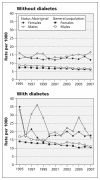Recent epidemiologic trends of diabetes mellitus among status Aboriginal adults
- PMID: 21788417
- PMCID: PMC3168663
- DOI: 10.1503/cmaj.101882
Recent epidemiologic trends of diabetes mellitus among status Aboriginal adults
Abstract
Background: Little is known about longitudinal trends in diabetes mellitus among Aboriginal people in Canada. We compared the incidence and prevalence of diabetes, and its impact on mortality, among status Aboriginal adults and adults in the general population between 1995 and 2007.
Methods: We examined de-identified data from Alberta Health and Wellness administrative databases for status Aboriginal people (First Nations and Inuit people with treaty status) and members of the general public aged 20 years and older who received a diagnosis of diabetes mellitus from Apr. 1, 1995, to Mar. 31, 2007. We calculated the incidence and prevalence of diabetes and mortality rate ratios by sex and ethnicity in 2007. We examined the average relative changes per year for longitudinal trends.
Results: The average relative change per year in the prevalence of diabetes showed a smaller increase over time in the Aboriginal population than in the general population (2.39 v. 4.09, p < 0.001). A similar finding was observed for the incidence of diabetes. In the Aboriginal population, we found that the increase in the average relative change per year was greater among men than among women (3.13 v. 1.88 for prevalence, p < 0.001; 2.60 v. 0.02 for incidence, p = 0.001). Mortality among people with diabetes decreased over time to a similar extent in both populations. Among people without diabetes, mortality decreased in the general population but was unchanged in the Aboriginal population (-1.92 v. 0.11, p = 0.04). Overall, mortality was higher in the Aboriginal population than in the general population regardless of diabetes status.
Interpretation: The increases in the incidence and prevalence of diabetes over the study period appeared to be slower in the status Aboriginal population than in the general population in Alberta, although the overall rates were higher in the Aboriginal population. Mortality decreased among people with diabetes in both populations but was higher overall in the Aboriginal population regardless of diabetes status.
Figures


References
-
- Gracey M, King M. Indigenous health part 1: determinants and disease patterns. Lancet 2009;374:65–75 - PubMed
-
- Harris SB, Gittelsohn J, Hanley A, et al. The prevalence of NIDDM and associated risk factors in Native Canadians. Diabetes Care 1997;20:185–7 - PubMed
-
- Dean HJ, Young TK, Flett B, et al. Screening for type-2 diabetes in Aboriginal children in northern Canada. Lancet 1998;352: 1523–4 - PubMed
Publication types
MeSH terms
Grants and funding
LinkOut - more resources
Full Text Sources
Medical
Miscellaneous
